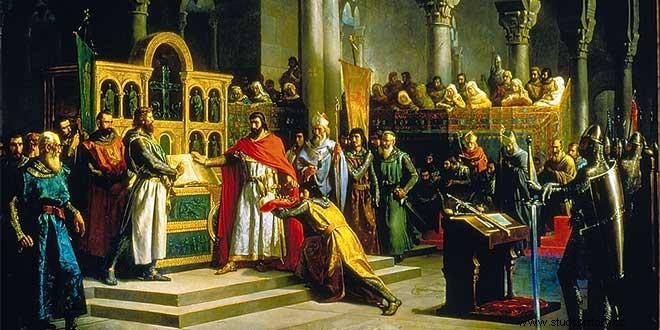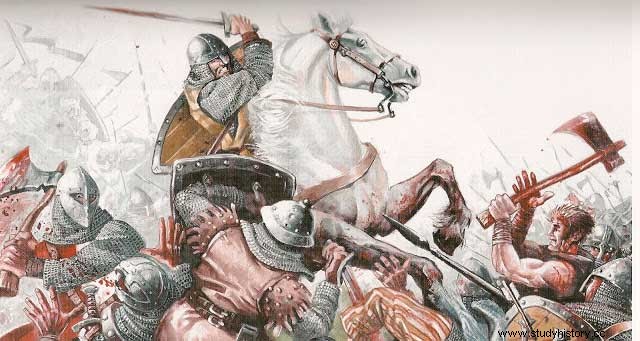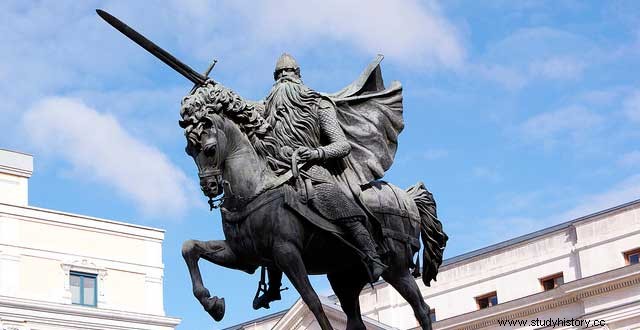Rodrigo Díaz de Vivar was an 11th century Castilian knight whom legend made the most outstanding hero of the Reconquest . He lived during the reigns of Fernando I of León, Sancho II of Castile and Alfonso VI of León and Castile. In the course of his military campaigns he managed to establish a solid protectorate in the kingdoms of Zaragoza and Valencia, a place he maintained until his death.
Childhood and education
Rodrigo Díaz de Vivar, el Cid, was born in Vivar around the year 1043. His parents were an infanzón and a lady of the high Castilian nobility, and he was educated together with the eldest son of King Fernando I of León, the infante Sancho . Over the years, the latter knighted him and shared with him the first of his military expeditions, in which he came to the aid of the tributary Moorish king of Zaragoza, Muqtadir. That same year, 1063, Fernando I died and distributed his kingdom among his three sons :Sancho, Alfonso and Garcia. To the former he ceded Castile and the Moorish kingdom of Zaragoza; to the second, the imperial kingdom of León, and to the third, that of Galicia, Portugal and the tributary kingdoms of Seville and Badajoz.
Appointment of Rodrigo Díaz de Vivar
Sancho II, the new king of Castile, appointed Rodrigo Díaz alférez or standard bearer, and as such, he directed the multiple Castilian wars throughout the life of the monarch. Carrying out this position, Rodrigo participated in a single combat with the Navarrese knight Jimeno Garcés. The victory of Rodrigo, who was twenty-three years old at the time, earned Castile the ownership of several border castles, among them those of the Oca and Pazuengos mountains, and gave him the name of Campidoctor or Campeador , 'Winner of battles', with which he has gone down in history. The following year, 1067, upon defeating the Moorish king Muqtadir, the Hebrew chronicle of José ben Zaddic de Arévalo called him "Cidi Ru Díaz". In Hebrew "Cidi" is equivalent to 'my Cid', that is to say 'my lord', an expression with which his border vassals named him ever since .
Due to his position, the Cid had to intervene directly in the struggle for power unleashed as soon as Fernando died among his children. According to different historical documents and some romances, he had a decisive participation alongside Sancho el Fuerte in the battles of Llantada, on July 19, 1068, and Golpejera, against Alfonso, which determined his exile to the court of the Moorish king of Toledo, Mamun.
Death of sancho

Sancho was crowned King of León on January 12, 1072, although not all Leonese nobles recognized him as such . Meanwhile, Fernando's daughter, Doña Urraca, supported by supporters of her brother Alfonso, organized a rebellion in Zamora, which forced the King of Castile and León to lay siege to the city. During the siege, on Sunday October 7, Vellido Adolfo entered the royal camp and assassinated Sancho . Before the assassination, many knights dispersed, but the Cid, at the head of a group of faithful vassals, accompanied the corpse of his king to the Oña monastery.
The death of Sancho II was from the beginning suspicious to his subjects, among them the Cid, who, knowing of the incestuous love between Doña Urraca and Alfonso, could believe that it was an intrigue to restore the latter to the throne. . For this reason, El Cid, acting as an ensign, was in charge of taking the expurgation oath from Alfonso VI before recognizing vassalage, as contemplated by the Fuero Juzgo . This episode is known as the "oath of Santa Gadea", after which Rodrigo Díaz de Vivar:El Cid Campeador became part of Alfonso's court, while Pedro Ansúrez, Count of Carrión, and the Beni Gómez occupied the main positions in the court. government of the new monarch.
Marriage and appointments of the cid
Alfonso proposed a policy of rapprochement between Castilians and Leonese. To this end, he arranged the wedding of Rodrigo Díaz with Jimeña Díaz, his cousin and great-granddaughter of Alfonso V de León. Said marriage was celebrated, according to the letters of deposit that the Cid gave Jimena, on July 19, 1074. During Lent of the following year, the monarch went on a pilgrimage to Oviedo and dispatched some lawsuits, for which he appointed Rodrigo as judge. , who demonstrated to have a deep knowledge of the laws, especially the Jurisdiction Jurisdiction. Alfonso sent him at the end of 1079 to collect the outcasts or tributes from Al-Mutamid, king of Seville . Around the same time, Count García Ordóñez, a powerful Castilian tycoon, decided to participate in the quarrel between Al-Mutamid and the King of Granada, Abd Allah. To this end he entered the territory of Seville to harass him. Given the situation, El Cid came out in defense of Al-Mutamid and defeated the King of Granada and García Ordóñez at the Battle of Cabra.
It is possible that this act of arms, the gifts of thanks that El Cid received from Al-Mutamid and a subsequent incursion by the Castilian knight in Toledo, through lands surrounding the castle of Gormaz, justified the accusations that caused the exile in 1081 of the Cid , a penalty typical of the infanzones and rich-men, which was accompanied by the confiscation of all their assets.
Banishment of the Cid Campeador
Accompanied by his retinue, the Campeador went first to San Pedro de Cardeña, where Dona Jimena was taking refuge with her three small children, and later to Barcelona. Here he offered his services to Count Berenguer Ramón II, called the Fratricide for having murdered his brother Ramón de el. The lack of agreement between the Count of Barcelona and El Cid was due, apparently, to an imposition by Berenguer Ramón that would put him before the eventuality of fighting against Alfonso VI, whom he always recognized as his lord. He then went to Zaragoza and placed himself at the service of King Muqtadir, who died a short time later, dividing the kingdom between his two sons . He left the kingdom of Zaragoza to the eldest, Yusuf Mu'tamin, protected by Rodrigo and his Castilian retinue, and to the youngest, Mundir al-Hayib, he handed over Lérida, Tortosa and Denia, supported by Berenguer Ramón from Barcelona and Sancho Ramírez from Aragon. El Cid, who received an important salary for his military services, did not fight against Alfonso. Rather, he tried to support him in the incident of Rueda, in 1083, where the king was the victim of a betrayal, and later, in 1085 and 1086, when the Castilian monarch attacked Zaragoza. . Instead, he did not hesitate to enter the fray when Mundir and his protectors coalesced. In the Battle of Almenar he defeated them and took Berenguer himself prisoner. Following instructions from his protégé, he restored the castle of Olocau to neutralize the fortress of Morelia, and on August 14, 1084, he defeated Sancho Ramírez of Aragón.
Reconciliation with King Alfonso
After the defeat suffered on October 23, 1086 in the fields of Sagrajas, Alfonso VI recognized some political errors, which had motivated the invasion of the Almoravids of Yusuf, whom the Moorish kings recognized as the "emir of the Muslims" . This situation moved him to reconcile with Rodrigo in the spring of 1087 .
The meeting took place in Toledo. On that occasion, the Cid, following an ancient rite of submission, took grass between his teeth and knelt before Alfonso VI. This, for his part, made important concessions in castles, lands and towns, as well as all the territories that he could conquer in Levante, for him and his descendants. Rodrigo Díaz became one of the main contenders for the kingdom of Valencia.
Campaign in raising and new banishment
At first, the Cid was required by all those who wanted the Levantine city, but in the end he agreed with his king, Al-Qadir, and gave him his protection, dissuading Musta'in II, Berenguer and the king of lerida
El Cid's campaign in Levante managed to subject numerous Moorish kings to vassalage, but the situation entered a crisis when Alfonso VI, as a result of a disagreement with Rodrigo during the AJedo campaign, banished him again . Under the accusation of conspiring against the life of the monarch, Alfonso stripped the
Cid of all his property, sent Jimena and his three children to prison and expelled him from his domain. Rodrigo reacted by sending in his defense four different forms of exoneration oath, which showed his knowledge in legal matters, but he did not achieve any result, except for the freedom of his wife and his children. This moment was used by his Christian and Moorish enemies to attack him, but he responded by consolidating his fortresses in Levante.

Elcid expands the kingdom
In the early 1090s, he first defeated Mundir in Denia and swept from Orihuela to Játiva; in April he reached peace with the king of Lérida. As a consequence of her, Al-Qa-dir returned to pay him the outcasts and restored his friendship, while Berenguer sought an alliance with Musta'in of Zaragoza, in which he tried in vain to compromise Alfonso. At Tevar, in May 1090, he made a further display of courage and strategic ability by defeating Berenguer and his large army. The victory brought him valuable booty, including the sword Colada, which he would use from now on. Berenguer and the Catalan nobleman Giraldo Alemán, who had been imprisoned, paid a ransom of 80,000 gold marks from Valencia for their freedom. A month later King Mundir died, and his successor, Sulayman ibn Hud, recognized his vassalage to the Cid.
The following year, while Alfonso was facing new Almoravid incursions, Queen Constanza tried to intercede between her husband and El Cid, and she was about to succeed . In 1091 a new misunderstanding during the campaign of Granada gave rise to a new rupture. In May 1092 there was, as a consequence, an attempt to seize Valencia by Alfonso VI in coalition with Ramón Berenguer, Sancho Ramírez and the fleet from Genoa and Pisa. Cid's revenge was swift and he razed the lands of Calahorra and Nájera belonging to García Ordóñez, even reaching Logroño, sowing terror as he passed . The repercussion on Alfonso's mind was immediate and he wrote a letter to the Cid forgiving him and acknowledging guilt, at the same time that he returned all his assets and freed them from all his burdens.
Capture of Valencia
In October 1092 a revolution deposed and assassinated the king of Valencia, Al-Qadir, and imprisoned the vizier appointed by El Cid, Ibn al-Faray . The leader, Ibn Yahhaf, seized power and governed with the support of the Almoravids, who in small numbers had managed to penetrate the city. Ibn Yahhaf tried to create an independent kingdom from the Cid and the Almoravids, but he was practically surrounded by one and the other. The situation deteriorated until, in July 1903, the leader capitulated with El Cid, but Ibn Wayib, head of the Almoravid party, seized power taking advantage of the presence of friendly troops in Lorca. Rodrigo decided to lay siege to the city and in Rayosa he managed to repulse the Almoravids, under the command of Abu Bakr, Yusuf's son-in-law . The famine caused by the siege forced the Valencians to restore Ibn Yahhaf to the government and new negotiations for his surrender began in January 1094. As a guarantee of the new pacts, Rodrigo demanded the imprisonment of Ibn Wayib and the delivery of a Ibn Jahhaf's son as a hostage. El Cid occupied the city on June 15 of that same year; later, he accused Ibn Yahhaf of perjury and regicide, and sentenced him to death . On July 1, 1095, Ibn Yahhaf was buried up to his chest and burned alive. That same year, some disturbances caused by Muslims gave rise to the Cid to enter Valencia, establish his residence in the fortress, dispose of the mosque and put it under the patronage of Santa María. In an act of asserting his authority, he appointed the cleric Jerome Perigord bishop without royal consent, although he was later confirmed by Pope Urban II.
Elcid fights the almoravides
Meanwhile, the Almoravids, who had dethroned most of the Taifa kings, were advancing dangerously north. El Cid, with the help of King Pedro I of Aragon, defeated them at the battle of Bairén in January 1097. Months later, while El Cid was reinforcing the castle of Peña Cadiella and occupying the strongholds of Almenara and Murviedro, Alfonso was defeated in Consuegra. In the course of this battle, which took place in August, the only son of the Cid, Diego, died fighting alongside the king.
During the siege of Murviedro, the new count of Barcelona, Ramón Berenguer III, who had displaced his uncle when his participation in the murder of his brother was confirmed, had besieged the castle of Oropesa. But the young count withdrew when he agreed with the Cid to marry him to María, one of the daughters of the Castilian knight. Apparently, around the same time, the marriage of the Cid's other daughter, Cristina, to Ramiro de Navarra was also negotiated.
Death of cid
The intense warrior activity of Rodrigo Díaz and a serious illness suffered years before, in Daroca, had ostensibly sapped his strength to the point that months after the surrender of Valencia everyone appreciated his physical deterioration. Little less than a year after the capture of Murviedro, on July 10, 1099, El Cid died . It is said that his closest followers tore their clothes, tore their hair and beat their chests, while the women scratched their cheeks and covered their foreheads with ashes. But Valencia would not fall to the Almoravids immediately. Jimena, his widow, took over the government of the city and in it resisted the onslaught of the Muslims for three years. At the end of August 1101, the Almoravid general Mazdalí attacked Valencia and surrounded it for six months, after which Jimena requested help from Alfonso VI, who went in person at the head of an army . Between May 1 and 4, 1102, the Christian monarch and Rodrigo's widow left Valencia under Moorish rule.

